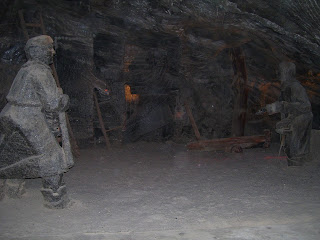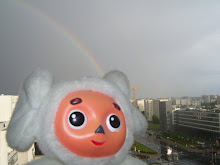It was a rainy and drizzly day in spring. Very dreary. The bus ride (a van, actually) there was around two hours, with the organizer calling us "my dears." We first went to Auschwitz I, entering a camp of large brick buildings not unlike dormitories (they were barracks first.) There is the "Arbeit Macht Frei" above the gate (Translated mostly as "Work makes you free." But I'm going to add the inevitable dash of extreme pretension and translate it with my rudimentary German as "Work Makes Free" (literal.) Anyway, the basic gist of it is "Work sets you free," "Through work, there is freedom," or "Within work, there is freedom." I think most people have the literal sense that they were trying to tell their captives that if they worked enough, they would be set free; however, I think it's more of how the prisoners should put their everything into work, let it define them, and through that they will spiritually be set free (but not actually set free.)) The tour guide was pretty good and gave us a tour of some of the buildings. The most horrifying exhibit was the hair of 40,000 women. In the same room was a bolt of cloth made from human hair and a Nazi officer's uniform made of the same material. It almost unbelievable to see the hair of 40,000 human beings piled up in a small mountain behind glass.

The notorious slogan. That lady in the middle there annoyed me by always getting in my shots (like this one.)

A barbed wire fence in Auschwitz I
Several tours were going around at the same time as we. The one right in front was a group from (presumably) Israel. Many members were draped with the Israeli flag and took to waving it from windows when they had the chance.
After the tour of Auschwitz I, we went for a break and ate at a small cafeteria. Back on the bus for the tour of Auschwitz II-Birkenau. This tour was less extensive. They showed us two of the buildings, one being the toilets. Then, they let us wander about for a half-hour before we had to leave. We elected to climb the main guard tower above the entrance.

The rain and mud made it even more somber.

A small group of Americans were left and we went to Wieliczka, home of the salt mine. This place is absolutely beautiful. The mine is defunct, and one might be thinking, "How interesting can a salt mine be?" I agree, salt is not actually the most interesting of compounds (chemists might disagree) and is a very basic seasoning. But there, there are sculptures, small lakes, a restaurant, an entire church, gigantic rooms, chandeliers made from salt crystals, and (this is the best part) you can lick the walls!!! The tour guide showed us on particular sculpture, which looked like it was carved from a normal type of stone (like a dark, dark jade), then stuck her flashlight against the stone to show how the stone was semi-translucent. The air is very nice and supposedly can work wonders for those with pulmonary ailments. It's pretty snazzy.

A salt sculpture (one of many.) In reality the salt is very dark and green. The effect of looking like frost or snow comes from the reflection off the salt crystals from the camera's flash.

A staircase leading ever downwards.
The tour ended, and we headed back to Krakow. Since our van was overflow from the bus and did not have TVs, we couldn't watch the introductory video on our way to Auschwitz. The organizer promised us that we could show up at the tour office the next day for a free DVD, but that was not the case. I think we came back more than a year later and asked for it, but no luck.






No comments:
Post a Comment